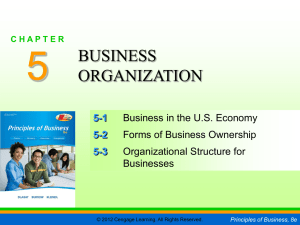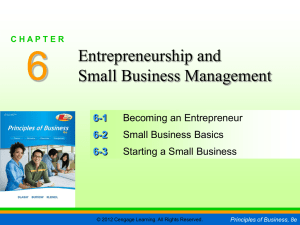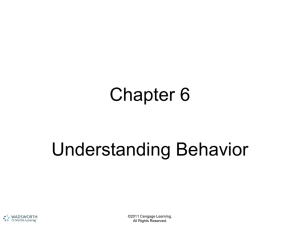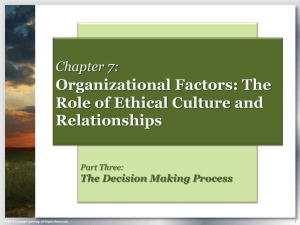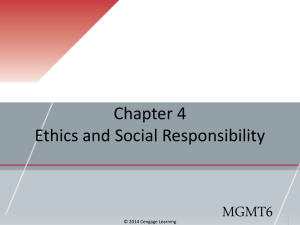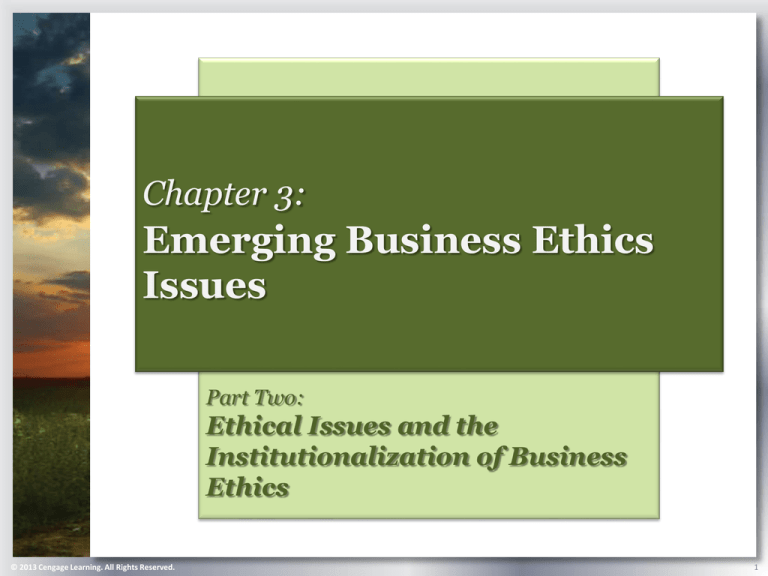
Chapter 3:
Emerging Business Ethics
Issues
Part Two:
Ethical Issues and the
Institutionalization of Business
Ethics
© 2013 Cengage Learning. All Rights Reserved.
1
Recognizing an Ethical Issue
An ethical issue is a problem, situation, or
opportunity that requires an individual or
group to choose among actions
New ethical issues are emerging constantly
Can be difficult to recognize ethical issues
Failure to do so puts corporations at risk
•
© 2013 Cengage Learning. All Rights Reserved.
Is a problem in industries where winning is
perceived to be a game
2
Specific Types of Observed Misconduct
© 2013 Cengage Learning. All Rights Reserved.
3
Honesty
Honesty: Truthfulness or trustworthiness
Telling the truth to the best of your knowledge
Dishonesty: A lack of integrity, incomplete
disclosure, or an unwillingness to tell the truth
Issues related to honesty arise when people
perceive business as something where
normal rules do not apply
© 2013 Cengage Learning. All Rights Reserved.
4
Fairness and Integrity
Fairness: The quality of being just,
equitable, and impartial
Equality: How wealth or income is distributed
Reciprocity: Occurs when an action that has an effect
upon another is returned
Optimization: The tradeoff between equity and
efficiency
Integrity: Uncompromising adherence to
ethical values
One of the most important terms relating to virtue
© 2013 Cengage Learning. All Rights Reserved.
5
Ethical Issues and Dilemmas in
Business
An ethical dilemma is a problem, situation, or
opportunity that requires an individual or
group to chose among several wrong or
unethical actions
There is no ethical choice
© 2013 Cengage Learning. All Rights Reserved.
6
Shareholder Issues
© 2013 Cengage Learning. All Rights Reserved.
7
Misuse of Company Resources
The leading form of observed misconduct
Can range from unauthorized use of
equipment and computers to embezzling
company funds
Time theft costs organizations hundreds of
billions in lost productivity annually
© 2013 Cengage Learning. All Rights Reserved.
8
Abusive or Intimidating Behavior
One of the most common ethical problems
Can be physical threats, false accusations,
profanity, insults, harshness, ignoring
someone, or unreasonableness
Intent is important in determining abuse
Bullying is a growing problem
•
© 2013 Cengage Learning. All Rights Reserved.
Is associated with a hostile workplace
9
Actions Associated with Bullies
© 2013 Cengage Learning. All Rights Reserved.
10
Lying
Three types of lies
Joking without malice
Commission lying is creating a false perception
with words that deceive the receiver
Creating noise
Omission lying is intentionally not informing
channel members of problems relating to a
product that affects awareness, intention, or
behavior
© 2013 Cengage Learning. All Rights Reserved.
11
Conflicts of Interest
Exist when an individual must choose
whether to advance his/her personal
interests, those of the organization, or
some other group
Individuals must separate personal interests
from business dealings
© 2013 Cengage Learning. All Rights Reserved.
12
Bribery
The practice of offering something in order
to gain an illicit advantage
Different types of bribery
Active bribery: The person who promises or gives
the bribe commits the offense
Passive bribery: An offense committed by the
official who receives the bribe
Facilitation payments: Legal as long as they
are small
© 2013 Cengage Learning. All Rights Reserved.
13
Corporate Intelligence
The collection and analysis of
information on
Markets
Technologies
Customers and competitors
Socioeconomic and external political trends
Three intelligence models
•
•
•
© 2013 Cengage Learning. All Rights Reserved.
Passive monitoring system for early warning
Tactical field support
Support dedicated to top management strategy
14
Corporate Intelligence
Hacking
System hacking
Remote hacking
Physical hacking
Social engineering
Shoulder surfing
Password guessing
Dumpster diving
Whacking
Phone eavesdropping
© 2013 Cengage Learning. All Rights Reserved.
15
Discrimination
Is illegal in the U.S.
A company can be sued for discrimination if it
Refuses to hire an individual for discriminatory
reasons
Unreasonably excludes an individual from
employment
Unreasonably discharges an individual
Discriminates against an individual with respect to
hiring, employment terms, promotion, or privileges
© 2013 Cengage Learning. All Rights Reserved.
16
Discrimination (continued)
Equal Employment Opportunity Commission
(EEOC)
The Age Discrimination in Employment Act
Affirmative Action Programs
Efforts to recruit, hire, train, and promote qualified
individuals from groups that have traditionally
been discriminated against
© 2013 Cengage Learning. All Rights Reserved.
17
Sexual Harassment
A repeated, unwanted behavior of a sexual
nature perpetrated upon an individual by
another
Hostile work environment
The conduct was unwelcome
The conduct was severe, pervasive, and regarded
by claimant as hostile/offensive
The conduct was such that a reasonable person
would find it hostile or offensive
© 2013 Cengage Learning. All Rights Reserved.
18
Dual Relationship
A personal, loving, and/or sexual
relationship with someone with whom you
share professional responsibilities
A key ethical issue in sexual harassment
Unethical dual relationship: The
relationship causes a conflict of interest or
impairment of professional judgment
© 2013 Cengage Learning. All Rights Reserved.
19
To Avoid Sexual Misconduct, a
Firm Needs
1.
2.
3.
4.
5.
Statement of policy
Definition of sexual harassment
Non-retaliation policy
Specific procedures for prevention
Establish, enforce, and encourage victims to
report
6. Establish a reporting procedure
7. Timely reporting requirements to the proper
authorities
© 2013 Cengage Learning. All Rights Reserved.
20
Environmental Issues
Are becoming significant concerns in
business
Air pollution: Gases and particulates in the air that
can linger or be carried long distances by winds
The Kyoto Protocol: An international treaty on climate
change that commits nations to reducing greenhouse
gas emissions
Water pollution: Results from dumping sewage
and toxic chemicals in places where they can filter
into water supplies
© 2013 Cengage Learning. All Rights Reserved.
21
Environmental Issues (continued)
Recycling: The reprocessing of materials,
especially steel, aluminum, paper, glass,
rubber, and some plastics
Consumers consider recycling to be the most
important thing they can do to live “greener” lives
Alternative energy: Is considered “green”
because it produces fewer emissions and
creates less pollution
Wind
Solar
Geothermal
© 2013 Cengage Learning . All rights reserved.
Hydropower
Biofuels
Nuclear
22
Consumers’ Favorite Green Practices
© 2013 Cengage Learning. All Rights Reserved.
23
Fraud
Any purposeful communication that
deceives, manipulates, or conceals facts in
order to create a false impression
Accounting fraud
Misrepresentation of company’s financial reports
Dramatic changes in accounting field
Increased competition and pressures to perform
can create opportunities for misconduct
Accountants should abide by a strict code of ethics
© 2013 Cengage Learning. All Rights Reserved.
24
Marketing Fraud
The process of dishonestly creating,
distributing, promoting, and pricing
products
Puffery: Exaggerated advertising claims,
blustering, and boasting
Can be difficult to distinguish from fraud
Implied falsity: An advertising message that
misleads, confuses, or deceives the public
Literally false: Claims can be divided into tests
prove and bald assertions (non-establishment
claims)
© 2013 Cengage Learning. All Rights Reserved.
25
Consumer Fraud
When consumers attempt to deceive
businesses for personal gain
Price tag switching, item switching, or lying to
obtain discounts
Collusion involves an employee who helps a
consumer commit fraud
Duplicity involves a consumer duping a store
Guile is associated with a person who uses
tricks to obtain an unfair advantage
© 2013 Cengage Learning. All Rights Reserved.
26
Financial Misconduct
The failure to understand and manage ethical
risks was a key problem in the recent financial
crisis
Many firms rewarded risk-taking
Difficult-to-understand financial instruments and
murky accounting played roles
Government calls for reform
Stricter controls on hedge funds and other
instruments
Greater transparency
Dodd-Frank Wall Street Reform and Consumer
Protection Act
© 2013 Cengage Learning. All Rights Reserved.
27
Insider Trading
Two types of insider trading
Legal insider trading: Involves legally buying
and selling stock in an insider’s own company,
but not all the time
Illegal insider trading: The buying or selling of
stocks by insiders who possess material that is
not public
© 2013 Cengage Learning. All Rights Reserved.
28
Intellectual Property Rights and
Privacy
Involve the legal protection of intellectual
properties
Books, movies, software
Can be difficult to enforce
Many privacy issues in the business world
Employee use of technology
Consumer privacy
Can be challenging for businesses today to meet
the needs of consumers while protecting privacy
Identity theft is a growing problem
© 2013 Cengage Learning. All Rights Reserved.
29
The Challenge of Determining
Ethical Issues in Business
Most ethical issues become visible through
stakeholder concerns
Determining ethical issues is a challenge
Changing societal standards over time
The ethical decision making process starts
when ethical issue awareness occurs and a
discussion begins
© 2013 Cengage Learning. All Rights Reserved.
30



